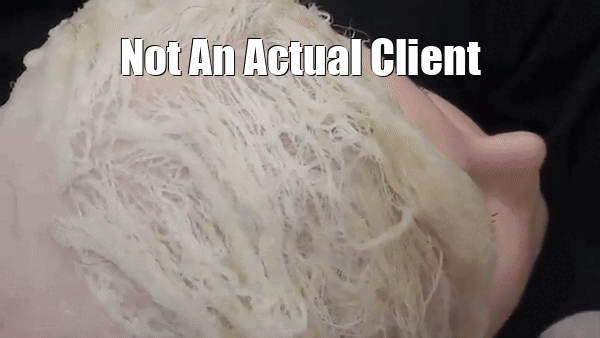We’ve seen a rise in the popularity of at-home hair lightening products like Sun Bum’s Sun-In Spray and John Frieda’s Go Blonder Shampoo. While these options may seem like convenient alternatives to bleach, it’s important to understand how they work, and the potential risks they can pose to your hair health, especially if you’re considering professional color treatments down the line.
At our studio, we’ve recently had several clients come in after using products like Go Blonder and Sun-In, and unfortunately, the results were far from what they expected. As much as we love helping you achieve your hair goals, there’s something important you need to know:
We cannot color your hair after using these products.
Yes, you read that right. Once you’ve applied these lightening sprays or shampoos, the damage they can cause may prevent us from performing any professional coloring services.
Why?

These lightening products contain ingredients that can have serious adverse reactions when mixed with professional oxidative hair coloring treatments or perm solutions. The combination of these chemicals with salon-grade products—whether you’re going lighter or darker—can leave your hair damaged beyond repair. It can become soft, gummy, and prone to breakage, and in severe cases, hair can even melt during the color or perm process.
1. Sun-In Spray
Sun-In uses hydrogen peroxide, a common lightening agent, to break down the pigment in your hair. However, when combined with lemon juice (citric acid) and alcohol, the hair becomes increasingly dry, fragile, and prone to snapping. The heat-activated process (whether by blow-dryer or sunlight) further amplifies this damage. Even if you used Sun-In years ago, peroxide residue can remain in the hair, leading to unpredictable reactions with professional coloring agents.
We’ve had cases where hair exposed to Sun-In over one year ago disintegrated after just a short exposure to salon lighteners. Hair turned to a gummy, stretchy texture and broke off—irreparably damaged.
2. Sun Bum Hair Lightener

Sun Bum operates in a similar way to Sun-In, combining hydrogen peroxide with lemon juice and alcohol to lighten hair when exposed to heat. The peroxide breaks down melanin in the hair, but also weakens the hair structure. Citric acid (from lemon) opens the cuticle even more, leaving your hair vulnerable. When used with heat or other chemical treatments, hair can become brittle, break off, or melt under stress from additional color processing.
We’ve seen cases where clients used Sun Bum over a year ago, and their hair still disintegrated upon exposure to professional salon products. It’s not uncommon for this damage to be hidden until a professional chemical service is performed, at which point the hair becomes too fragile to withstand the treatment.
3. John Frieda Go Blonder Shampoo
John Frieda’s Go Blonder Shampoo is marketed as a gentle, gradual lightener. However, it contains citrus extracts (citric acid) and peroxide derivatives that lighten hair over time. While it seems harmless, even prolonged use of this shampoo can leave your hair highly porous and fragile. The problem comes when we try to color over this; the peroxide residue in the hair can interact with professional oxidative colors, causing severe damage, breakage, or even chemical reactions that lead to disintegration.
Another concerning ingredient in this product is Sodium Hydroxide, commonly known as lye.

Sodium Hydroxide (or lye) is typically used to control pH levels and can be found in small amounts in various products. However, lye is a highly caustic chemical that, if overused or combined with certain ingredients, can severely damage hair. Sodium hydroxide breaks down the hair’s natural structure, making it more prone to damage. In the case of Go Blonder, it can lead to dryness, brittleness, and an increased risk of hair breakage—especially if used with professional coloring agents.
Even clients who used Go Blonder over a year ago have experienced their hair turning gummy and disintegrating within minutes of exposure to lighteners or perms.
The Reality of DIY Hair Lightening Products
While these products promise gradual, “sun-kissed” lightening, they often leave behind long-term damage that only becomes apparent when you attempt to color or perm your hair professionally. Sun-In, Sun Bum, and Go Blonder might deliver temporary results, but the damage can be significant and often irreversible.
Why Professional Stylists Are Reluctant to Color Over These Products
- Residual Peroxide and Lye:
Even years after you stop using these products, hydrogen peroxide and sodium hydroxide can remain inside the hair. These chemicals react poorly with any oxidative treatments, whether you’re going lighter or darker, or trying to perm your hair. The outcome can be disastrous—ranging from breakage to melting. - Hair Condition and Integrity:
By the time you come in for professional coloring or a perm, your hair may already be structurally compromised from these products. The damage weakens the cuticle and the internal structure, meaning your hair is too fragile to withstand any additional chemical processing, leading to complete breakdown during the service. - Unpredictable Chemical Reactions:
Even if you used these products years ago, the residual chemicals can interact with salon-grade treatments in unpredictable ways. When exposed to oxidative color, bleach, or perm solutions, the hair might disintegrate, melt, or break, leaving little to work with.
Be Honest with Your Stylist!
If you’ve used Sun-In, Sun Bum, Go Blonder, or similar products, please be honest during your consultation. This transparency allows us to create a safe, effective plan for your hair. Many clients believe these products wash out over time, but the truth is that their ingredients can linger and cause chemical reactions years later.
How to Safeguard Your Hair Moving Forward
If you’ve used any of these DIY lighteners, schedule a consultation before attempting professional hair coloring or perming. We’ll assess your hair’s condition and perform swatch tests to see how it reacts to professional products. This allows us to determine what steps can be taken to repair and strengthen your hair before moving forward with any color or perm services.
The Importance of Strand Tests
We always recommend an in-person consultation to assess the overall health of your hair. A strand test is critical, where we apply a small amount of lightener, color, or perm solution to a discreet section of your hair to evaluate its reaction. This test helps us avoid severe, irreversible damage.
Final Takeaway:
While products like Sun-In, Sun Bum, and Go Blonder promise gradual lightening, their long-term effects can prevent stylists from safely performing color or perm services. Ingredients like hydrogen peroxide, citric acid, and sodium hydroxide (lye) can leave lasting damage that interacts poorly with any oxidative treatments. If you’ve used any of these products, be upfront with your stylist and ensure your hair undergoes proper testing before further treatments. We’re here to help guide you toward the healthiest possible hair journey!